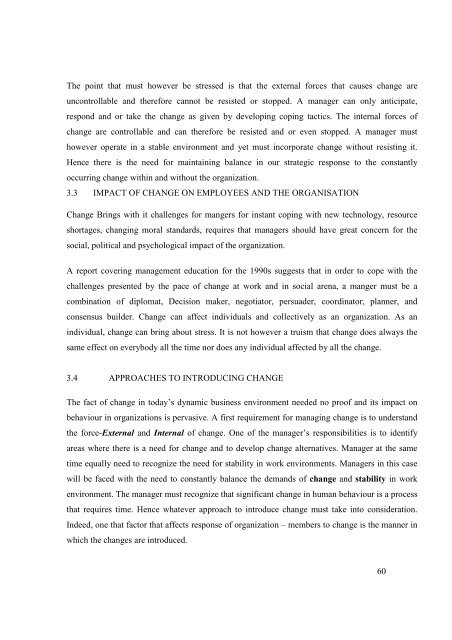HCM 433 MANGEMENT AND ORGANIZATIONAL BEHAVIOUR.pdf
HCM 433 MANGEMENT AND ORGANIZATIONAL BEHAVIOUR.pdf
HCM 433 MANGEMENT AND ORGANIZATIONAL BEHAVIOUR.pdf
You also want an ePaper? Increase the reach of your titles
YUMPU automatically turns print PDFs into web optimized ePapers that Google loves.
The point that must however be stressed is that the external forces that causes change are<br />
uncontrollable and therefore cannot be resisted or stopped. A manager can only anticipate,<br />
respond and or take the change as given by developing coping tactics. The internal forces of<br />
change are controllable and can therefore be resisted and or even stopped. A manager must<br />
however operate in a stable environment and yet must incorporate change without resisting it.<br />
Hence there is the need for maintaining balance in our strategic response to the constantly<br />
occurring change within and without the organization.<br />
3.3 IMPACT OF CHANGE ON EMPLOYEES <strong>AND</strong> THE ORGANISATION<br />
Change Brings with it challenges for mangers for instant coping with new technology, resource<br />
shortages, changing moral standards, requires that managers should have great concern for the<br />
social, political and psychological impact of the organization.<br />
A report covering management education for the 1990s suggests that in order to cope with the<br />
challenges presented by the pace of change at work and in social arena, a manger must be a<br />
combination of diplomat, Decision maker, negotiator, persuader, coordinator, planner, and<br />
consensus builder. Change can affect individuals and collectively as an organization. As an<br />
individual, change can bring about stress. It is not however a truism that change does always the<br />
same effect on everybody all the time nor does any individual affected by all the change.<br />
3.4 APPROACHES TO INTRODUCING CHANGE<br />
The fact of change in today’s dynamic business environment needed no proof and its impact on<br />
behaviour in organizations is pervasive. A first requirement for managing change is to understand<br />
the force-External and Internal of change. One of the manager’s responsibilities is to identify<br />
areas where there is a need for change and to develop change alternatives. Manager at the same<br />
time equally need to recognize the need for stability in work environments. Managers in this case<br />
will be faced with the need to constantly balance the demands of change and stability in work<br />
environment. The manager must recognize that significant change in human behaviour is a process<br />
that requires time. Hence whatever approach to introduce change must take into consideration.<br />
Indeed, one that factor that affects response of organization – members to change is the manner in<br />
which the changes are introduced.<br />
60
















